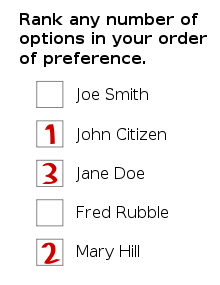First-preference votes

Example ranked voting voting ballot. John Citizen is the first preference on this ballot
In ranked-voting systems, a first-preference vote (or first preference, 1st preference, or primary vote) is the individual voter's first choice amongst (possibly) many.[1][2][3][4] Every such system is designed, in the first instance, to align the result with the candidate(s)/option(s) which have obtained the highest number of first preferences, and then, if necessary, this criterion is altered to allow for proportionality, and to carry surplus and/or ineffective votes to second and subsequent options depending on the system involved. Ballots with no clear first preference (no preference, or multiple first preferences) are generally regarded as a spoilt vote The term is also used (trivially) in first past the post systems.[5] First-preference votes are used by psephologists and the print and broadcast media to broadly describe the state of the parties at elections and the swing between elections.[4][5][6] The term is much-used in Australian politics, where preferential voting has been universal at federal, state, and local levels since the 1920s.
References
^ "Explainer: What is preferential voting?". Special Broadcasting Service..mw-parser-output cite.citation{font-style:inherit}.mw-parser-output .citation q{quotes:"""""""'""'"}.mw-parser-output .citation .cs1-lock-free a{background:url("//upload.wikimedia.org/wikipedia/commons/thumb/6/65/Lock-green.svg/9px-Lock-green.svg.png")no-repeat;background-position:right .1em center}.mw-parser-output .citation .cs1-lock-limited a,.mw-parser-output .citation .cs1-lock-registration a{background:url("//upload.wikimedia.org/wikipedia/commons/thumb/d/d6/Lock-gray-alt-2.svg/9px-Lock-gray-alt-2.svg.png")no-repeat;background-position:right .1em center}.mw-parser-output .citation .cs1-lock-subscription a{background:url("//upload.wikimedia.org/wikipedia/commons/thumb/a/aa/Lock-red-alt-2.svg/9px-Lock-red-alt-2.svg.png")no-repeat;background-position:right .1em center}.mw-parser-output .cs1-subscription,.mw-parser-output .cs1-registration{color:#555}.mw-parser-output .cs1-subscription span,.mw-parser-output .cs1-registration span{border-bottom:1px dotted;cursor:help}.mw-parser-output .cs1-ws-icon a{background:url("//upload.wikimedia.org/wikipedia/commons/thumb/4/4c/Wikisource-logo.svg/12px-Wikisource-logo.svg.png")no-repeat;background-position:right .1em center}.mw-parser-output code.cs1-code{color:inherit;background:inherit;border:inherit;padding:inherit}.mw-parser-output .cs1-hidden-error{display:none;font-size:100%}.mw-parser-output .cs1-visible-error{font-size:100%}.mw-parser-output .cs1-maint{display:none;color:#33aa33;margin-left:0.3em}.mw-parser-output .cs1-subscription,.mw-parser-output .cs1-registration,.mw-parser-output .cs1-format{font-size:95%}.mw-parser-output .cs1-kern-left,.mw-parser-output .cs1-kern-wl-left{padding-left:0.2em}.mw-parser-output .cs1-kern-right,.mw-parser-output .cs1-kern-wl-right{padding-right:0.2em}
^ "How the Dáil is Elected" (PDF). Department of the Environment, Community and Local Government, (Ireland). November 2014. p. 10. Retrieved 24 May 2015.
^ ""Full transcript - David Cameron - The case against AV - London - 18 February 2011"". New Statesman. 18 February 2011. Retrieved 24 May 2015.
^ ab "By-Election: Carlow-Kilkenny". RTÉ. 23 May 2015. Retrieved 24 May 2015.
^ ab "First Preference Vote". University of Western Australia. Retrieved 24 May 2015.
^ "Cooma-Monaro Shire Council: Summary of First Preference Votes for each Candidate". Local Government Elections 2012. Electoral Commission of New South Wales. 14 September 2012. Retrieved 7 October 2012.
This election-related article is a stub. You can help Wikipedia by expanding it. |